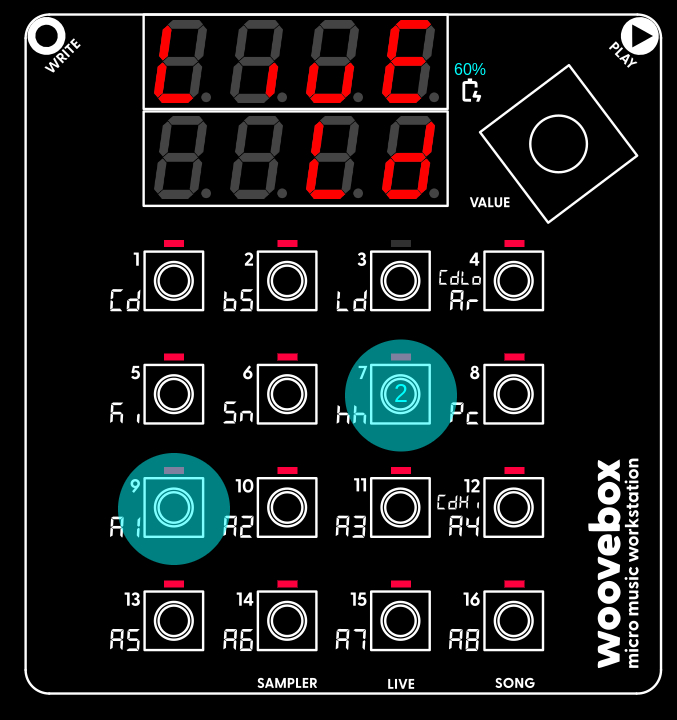- Guides, tutorials and docs
- Learning the Woovebox
- The very basics
- Quick start guide and video
- Tempo and BPM
- Tracks
- Patterns
- Live pattern recording
- Conditional triggering and modification
- Chords
- Arpeggios
- Scales and modes
- Full song writing
- Genres
- Presets
- Sound design
- Paraphonic parts
- Multi-instrument mode
- Risers, fallers, sweeps & ear candy
- Live mode
- Song mode
- Sampler
- Sidechaining, gating, ducking and compression
- Mastering
- Lo-fi & vintage analog and digital emulation
- Randomization
- Hall effect sensor playing
- Advanced techniques
- Undo
- Boot modes
- MIDI, Sync and connecting other gear
- Wireless MIDI over BLE
- Battery and charging
- Hardware quirks and limitations
- Understanding DSP load
- Looking after your Woovebox
- Firmware updates
- Performing with Live mode
- Live jamming
Live jamming

Despite its limitations, the Woovebox keyboard can be surprisingly expressive and very much suitable for live playing and improvising complex melodies.
Combined with legato, you can even dynamically create pitch glides; hold 1-16, then quickly play another 1-16 to slide from the first held 1-16 pitch to the second played 1-16 pitch. Note that to use glides, the patch needs to be configured to allow this. You can configure your patch on the 'Pich' (pitch) page; set Live Glide (LLGL) under 3/Ld to 'on'. Then set Legato Speed (LEG.S) under 7/hh to a value other than 0 to control the glide speed.
The way the keyboard translates key presses into note pitches, depends on how the FLW.C (follow chord) parameter on the 'Glob' (global) page is configured for your patch. For example, key presses may be automatically "pulled" toward the root note of the chord that is currently playing, or key presses may be automatically translated to the "legal" notes of the musical scale for your song. Please refer to the documentation to learn more about all the different modes at your disposal.
You may also be interested in...
- Create a final track with Song mode (under Quick start guide and video)
Much like editing notes on tracks, in a Song mode fragment you can hold an active (e.g. "lit up") track and edit a number of settings.
- Song Mode (under Cheat sheet)
Use Fragment (mutes/unmutes/solos) in Sequencer / Track Edit mode.
- Restoring patches (under Wooveconnect)
You do not have to be on the patch ("PAch") page for that track.
- Method 1 (under Arpeggios)
The way the track reacts to the current chord being played, determines how any steps are translated into note pitches.
- 4. Ch.rP Chain Repeat (under Patterns)
Specifies how many times the current pattern should play before switching to the next pattern (as specified by Ch.nE).
- Guides, tutorials and docs
- Learning the Woovebox
- The very basics
- Quick start guide and video
- Tempo and BPM
- Tracks
- Patterns
- Live pattern recording
- Conditional triggering and modification
- Chords
- Arpeggios
- Scales and modes
- Full song writing
- Genres
- Presets
- Sound design
- Paraphonic parts
- Multi-instrument mode
- Risers, fallers, sweeps & ear candy
- Live mode
- Song mode
- Sampler
- Sidechaining, gating, ducking and compression
- Mastering
- Lo-fi & vintage analog and digital emulation
- Randomization
- Hall effect sensor playing
- Advanced techniques
- Undo
- Boot modes
- MIDI, Sync and connecting other gear
- Wireless MIDI over BLE
- Battery and charging
- Hardware quirks and limitations
- Understanding DSP load
- Looking after your Woovebox
- Firmware updates